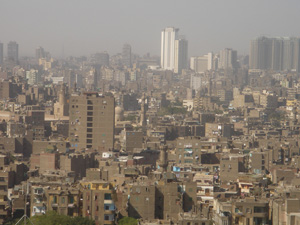Semester at
Sea Fall
2006 Voyage 
TABLE
OF CONTENTS
Skirting the Outskirts

by Ryan Bahry
As I drove through the deserts of Egypt, I stared out the window of the motor coach and gazed at the vast, expansive wasteland, the dunes of sand that stretched forever. Suddenly, the city of Cairo appears in the distance, and it seems to rise up from the nothingness—one second, desert as far as the eye can see and the next, the sprawl of the city. One of the most striking first impressions I had while encroaching upon Cairo was the fact that the buildings I observed seemed to be large numbers of apartment buildings or housing units, many of which seemed only half-completed. It was easy to observe the emptiness of many of these buildings through the gaping windows, and in some cases, there were furniture and other items located on the rooftops.
In Mike Davis’ article, “The Prevalence of Slums”, he discusses the phenomena of slums in urban settings, their developmental patterns and how they are reinforced by social institutions. As opposed to American cities where the slums are typically concentrated in the centers or cores, Davis discusses the way in which European cities more commonly concentrate the slum areas in the outskirts of the city. Cairo appeared to follow a much more European pattern in this regard. When I went to the areas that seemed to comprise much of the core of the city, I observed an extremely transnational atmosphere, one that seemed to retain a certain level of vernacular in order to create an ethnic appeal. The Nile river was lined with beautiful ships that would take tourists out on the famous body of water, while others served as upscale restaurants. The downtown shopping area, although not necessarily offering such recurring labels as Prada or Lacoste, was definitely composed of modern clothing stores, electronics, and resembled most of the other shopping centers we had seen throughout the various countries. Located a short distance from the more modern shopping centers was the city’s largest bazaar, the Khan-el Khalili. Even this bazaar, though it still wound through the narrow, twisting streets and offered a vernacular environment, still felt like a tourist-inspired destination. In Cairo’s downtown region, I observed little in the way of slums or tenements, most likely in large part to the efforts to create an elite and tourist-friendly urban center.
On the other hand, when I finally went off on my own, I was able to take a taxi ride through the outskirts of the city, and I was able to observe more of the buildings that I witnessed the first day arriving into Cairo. Vast expanses of these housing buildings stretched through the city, many of them appearing desolate and devoid of life. It was interesting to observe the ways in which a city such as Cairo, while trying to preserve a vernacular atmosphere in order to entice tourism, moves the local people out of the core of the city. It suggests that while we want to experience the vernacular, we tend to desire the transnational, comfortable norms and a vernacular that is custom-made.